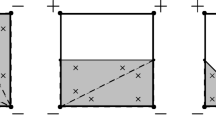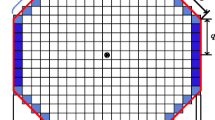Abstract
When using the robust topology optimization formulation in the density framework, the minimum size of the solid and void phases must be imposed implicitly through the parameters that define the density filter and the smoothed Heaviside projection. Finding these parameters can be time consuming and cumbersome, hindering a general code implementation of the robust formulation. Motivated by this issue, in this article, we provide analytical expressions that explicitly relate the minimum length scale and the parameters that define it. The expressions are validated on a density-based framework. To facilitate the reproduction of results, MATLAB codes are provided.


















Similar content being viewed by others
Notes
For the sake of clarity, this manuscript changes two notations with respect to Qian and Sigmund (2013). Here, \(2r_{\text {min.Solid}}^{\text {int}}\) and \(r_{\min \limits }\) respectively represent b and R in the cited article.
The maximum size is actually imposed using an annular region (Fernández et al. 2020), but for illustrative purposes, a circular region is drawn.
References
Andreasen CS, Elingaard MO, Aage N (2020) Level set topology and shape optimization by density methods using cut elements with length scale control. Struct Multidiscip Optim: 1–23
Bendsøe MP (1989) Optimal shape design as a material distribution problem. Struct Optim 1:193–202
Bendsøe MP, Kikuchi N (1988) Generating optimal topologies in structural design using a homogenization method. Comput Methods Appl Mech Eng 71(2):197–224
Bourdin B (2001) Filters in topology optimization. Int J Numer Methods Eng 50(9):2143–2158
Bruns TE, Tortorelli DA (2001) Topology optimization of non-linear elastic structures and compliant mechanisms. Computer Methods Appl Mech Eng 190(26-27):3443–3459
Chen S, Chen W (2011) A new level-set based approach to shape and topology optimization under geometric uncertainty. Struct Multidiscip Optim 44(1):1–18
Christiansen R, Lazarov B, Jensen J, Sigmund O (2015) Creating geometrically robust designs for highly sensitive problems using topology optimization: acoustic cavity design. Struct Multidiscip Optim 52:737–754
Clausen A, Andreassen E (2017) On filter boundary conditions in topology optimization. Struct Multidiscip Optim 56(5):1147– 1155
da Silva GA, Beck AT, Sigmund O (2019) Topology optimization of compliant mechanisms with stress constraints and manufacturing error robustness. Comput Methods Appl Mech Eng 354:397– 421
Fernández E, Kk Yang, Koppen S, Alarcón P, Bauduin S, Duysinx P (2020) Imposing minimum and maximum member size, minimum cavity size, and minimum separation distance between solid members in topology optimization. Comput Methods Appl Mech Eng 368:113157
Fernández E, Ayas C, Langelaar M, Duysinx P (2021) Topology optimization for large-scale additive manufacturing: Generating designs tailored to the deposition nozzle size (Under Review)
Lazarov BS, Sigmund O (2011) Filters in topology optimization based on helmholtz-type differential equations. Int J Numer Methods Eng 86(6):765–781
Pedersen C, Allinger P (2006) Industrial implementation and applications of topology optimization and future needs, vol 137. Springer, Berlin, pp 229–238
Pellens J, Lombaert G, Lazarov B, Schevenels M (2018) Combined length scale and overhang angle control in minimum compliance topology optimization for additive manufacturing. Struct Multidiscipl Optim
Qian X, Sigmund O (2013) Topological design of electromechanical actuators with robustness toward over-and under-etching. Comput Methods Appl Mech Eng 253:237–251
Sigmund O (1997) On the design of compliant mechanisms using topology optimization. J Struct Mech 25(4):493–524
Sigmund O (2009) Manufacturing tolerant topology optimization. Acta Mech Sinica 25(2):227–239
Sigmund O, Maute K (2013) Topology optimization approaches. Struct Multidiscip Optim 48 (6):1031–1055
Silva G, Beck A, Sigmund O (2020) Topology optimization of compliant mechanisms considering stress constraints, manufacturing uncertainty and geometric nonlinearity. Comput Methods Appl Mech Eng 365:112972
Wang F, Lazarov BS, Sigmund O (2011) On projection methods, convergence and robust formulations in topology optimization. Struct Multidiscip Optim 43(6):767–784
Wang F, Jensen J, Sigmund O (2011b) Robust topology optimization of photonic crystal waveguides with tailored dispersion properties. JOSA B 28:387–397
Wang F, Lazarov BS, Sigmund O, Jensen JS (2014) Interpolation scheme for fictitious domain techniques and topology optimization of finite strain elastic problems. Comput Methods Appl Mech Eng 276:453–472
Xu S, Cai Y, Cheng G (2010) Volume preserving nonlinear density filter based on heaviside functions. Struct Multidiscip Optim 41(4):495–505
Yan S, Wang F, Sigmund O (2018) On the non-optimality of tree structures for heat conduction. Int J Heat Mass Transf 122:660–680
Zhou M, Fleury R, Patten S, Stannard N, Mylett D, Gardner S (2011) Topology optimization-practical aspects for industrial applications. In: 9th World congress on structural and multidisciplinary optimization
Zhu JH, Zhang WH, Xia L (2016) Topology optimization in aircraft and aerospace structures design. Arch Comput Methods Eng 23:595–622
Funding
The authors acknowledge the research project FAFil (Fabrication Additive laser par dépôt de Fil), funded by INTERREG V A Grande Région and the European Regional Development Fund (ERDF).
Author information
Authors and Affiliations
Corresponding author
Ethics declarations
Conflict of interest
The authors declare that they have no conflict of interest.
Additional information
Responsible Editor: Gengdong Cheng
Replication of results
This manuscript contains two MATLAB codes as supplementary material that can be found on GitHubsFootnote 3. The first is called SizeSolution.m and provides a list of filter and projection parameters that impose user defined minimum length scales. The second is called NumericalSolution.m and builds the graphs in Fig. 6 using the numerical method proposed by Wang et al. (2011).
Publisher’s note
Springer Nature remains neutral with regard to jurisdictional claims in published maps and institutional affiliations.
Appendix
Appendix
As we show the contour plot of the minimum sizes ratio, it is possible to produce the same kind of figure for the offset distances. These are plotted in Fig. 19 and illustrate again the symmetric behavior of the sizes with the threshold values for a case where ηint = 0.5.
Rights and permissions
About this article
Cite this article
Trillet, D., Duysinx, P. & Fernández, E. Analytical relationships for imposing minimum length scale in the robust topology optimization formulation. Struct Multidisc Optim 64, 2429–2448 (2021). https://doi.org/10.1007/s00158-021-02998-w
Received:
Revised:
Accepted:
Published:
Issue Date:
DOI: https://doi.org/10.1007/s00158-021-02998-w





